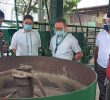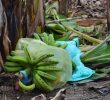DAVAO CITY, Philippines — Cavendish banana continue to drop its production as “Panama disease” coupled with the devastations of the El Niño phenomenon continues to affect huge hectares of agricultural lands in the region.
The situation has also led to a drop in the demand for export from the major international market for Cavendish banana such as China.
Mindanao Banana Farmers and Exporters Association (MBFEA) executive director Gladys Mebrano-Garcia also explained the many factors that cause the decrease of banana production especially among the small and medium banana growers in the region.
The decrease, she added, has also affected the big chunk of the exportation and local buy out of bananas.
Panama disease, Garcia said, is considered the primary reason for it continues to affect banana plantations in the area.
Panama disease is caused by soil-inhabiting fungus species called Fusarium oxysporum forma specialis cubense that affected around 15 thousand hectares of banana plantations since 2015.
The data on the devastations of Panama disease is based on the Department of Agriculture’s geo-tagging map.
The sudden change of climate, from the successive flooding in the earlier months of 2019 and the drought caused by the El Niño phenomenon is another factor, Garcia said.
Garcia told reporters on Monday, April 1, that many of the small and medium banana growers, mostly in Davao del Norte have already abandoned their banana production and converted their cropping to corn and palm oil.
“The industry is threatened by Panama disease, a very serious pathogen. It is a fungus that we still do not have a cure up to the present” Garcia said.
The disease was recorded to have a larger effect in the areas of Panabo City, Kapalong and Asuncion in Davao del Norte, as well as in Calinan in Davao City.
Though she did not mention the number of percentage of decreasing production of banana in the market, Garcia said that it has a huge effect on the number of volumes produced by local banana growers, as well as the specific variety demanded by buyers in the market.
“Since 2018, the volume really went down. Even if foreign buyers are coming in, but we cannot do it because we don’t have enough volume,” Garcia added.
On the other hand, in a separate interview, Melanie Provido of the High-Value Crops Development Program (HVCDP) of the Department of Agriculture in Davao Region (DA-11) told Davao Today that the agency has been active to its program to help banana farmers affected by the Panama disease.
In their monitoring, there are only 5 thousand hectares of banana plantations affected by Panama disease from the 15 thousand hectares reported in 2015.
Most of these affected areas are in Davao del Norte, Provido added.
“Because of our effort to educate the banana farmers, they became knowledgeable on how to combat the disease,” Provido said.
HVCDP introduced the Giant Cavendish Tissue Culture Variant (GCTCV) 218 in 2018 to banana farmers which is a clone that is resistant to the Panama disease.
But MBFEA, for their part, said the GCTCV 218 has a limited market since it is not the preferred in markets in China. (davaotoday.com)










